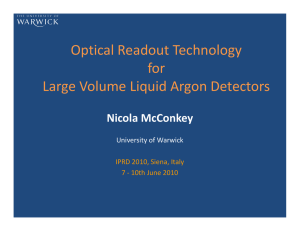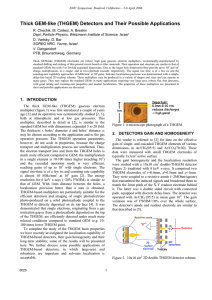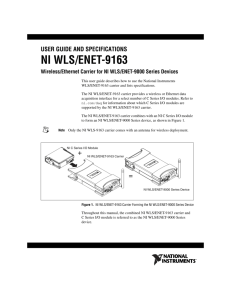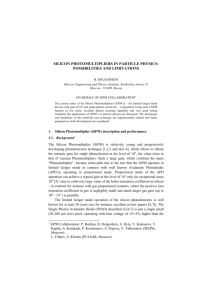Development of photo detection system based on THGEM
advertisement
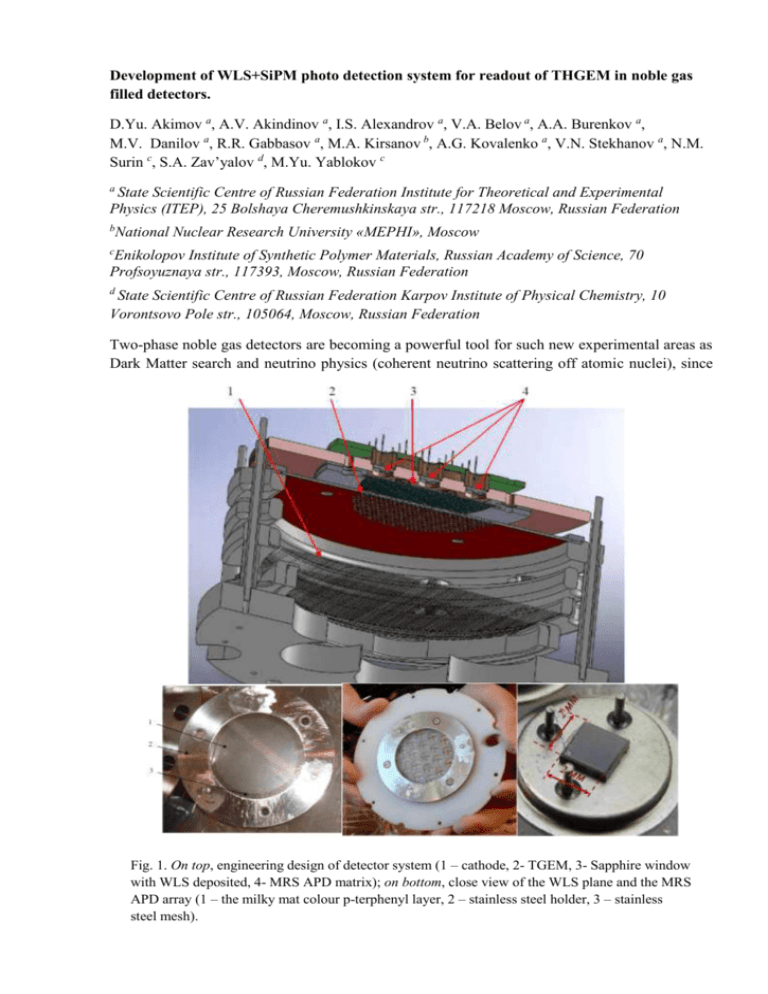
Development of WLS+SiPM photo detection system for readout of THGEM in noble gas filled detectors. D.Yu. Akimov a, A.V. Akindinov a, I.S. Alexandrov a, V.A. Belov a, A.A. Burenkov a, M.V. Danilov a, R.R. Gabbasov a, M.A. Kirsanov b, A.G. Kovalenko a, V.N. Stekhanov a, N.M. Surin c, S.A. Zav’yalov d, M.Yu. Yablokov c a State Scientific Centre of Russian Federation Institute for Theoretical and Experimental Physics (ITEP), 25 Bolshaya Cheremushkinskaya str., 117218 Moscow, Russian Federation b National Nuclear Research University «MEPHI», Moscow c Enikolopov Institute of Synthetic Polymer Materials, Russian Academy of Science, 70 Profsoyuznaya str., 117393, Moscow, Russian Federation d State Scientific Centre of Russian Federation Karpov Institute of Physical Chemistry, 10 Vorontsovo Pole str., 105064, Moscow, Russian Federation Two-phase noble gas detectors are becoming a powerful tool for such new experimental areas as Dark Matter search and neutrino physics (coherent neutrino scattering off atomic nuclei), since Fig. 1. On top, engineering design of detector system (1 – cathode, 2- TGEM, 3- Sapphire window with WLS deposited, 4- MRS APD matrix); on bottom, close view of the WLS plane and the MRS APD array (1 – the milky mat colour p-terphenyl layer, 2 – stainless steel holder, 3 – stainless steel mesh). they are very sensitive to weak ionisation signals because of a very intense proportional scintillation (electroluminescence), which takes place in the gas phase under applied electric field. Namely, even the only electron extracted through the liquid-gas interface can be easily detected as they produce sufficient amount of light (in the VUV region, 175 nm for Xe). This R&D study was aimed to demonstrate a new readout system for the signals with small energy deposition in a two-phase xenon detector based on a THGEM (Thick Gas Electron Multiplier) with light detection by WLS+SiPM. This system provides the following advantages with respect to a traditional readout of the electroluminescent signal in the gas phase with PMTs: 1. It brings much less radioactivity than PMTs. The last ones (even specially developed lowactivity models) are still the most radioactive element of a low-background detector. 2. It gives additional light that increases the total number of collected photons. In the case of the mode of proportional scintillation only or with small avalanche multiplication (≤10) in THGEM provides better single electron resolution. 3. It provides a spatial resolution with ~mm accuracy in XY plane (parallel to the surface of liquid) for events with a magnitude of ionisation signal of one or few electrons, which cannot be achieve with PMT readout. Several technical problems have been solved for the first time. In particular, the problem of a Wavelength Shifter (WLS) for light conversion from the VUV emission region of Xe (175 nm) to the sensitivity region of multipixel avalanche Geiger photodiodes (G-APD, MRS APD or SiPM). For this, the study of absorption and luminescence properties of the p-terphenyl (PTP) has been performed, and the protection technique of the PTP film was developed with the use of poly-para-xylylen (Parylen N) to prevent PTP from penetration to the liquid Xe. The WLS converter is deposited on a 1-mm, 50-mm in diam. sapphire disk. The disk is situated between THGEM and photodetectors with the sapphire side faced to THGEM. After first successful tests with MRS APD (produced by CPTA company) and WLS coupling [1, 2, 3] the system consisted of THGEM, WLS and an array of 19 MRS APD was designed and has been assembled. A successful performance of a new detection system (THGEM+WLS+SiPM) in the two-phase xenon chamber has been demonstrated in the test in December 2010. It should be remarked that such a system with a multichannel readout was developed and tested in the liquid Xe for the first time. During the tests, it has been shown that THGEM can operate in a two-phase mode, giving substantial increase of the electroluminescence signal, and thus, providing the higher sensitivity of a two-phase detector to the extremely weak ionisation signals. XY position of the event is determined by a centroid method with the use of signals from several APDs. Fig. 3. Signals from the PMT array (pink) and the MRS APD array (black). PMT signal has two parts: drift of electron in gas Xe and electroluminescent signal from THGEM. Corresponding signal from MRS APD array coincides with the second part of the PMT signal. Fig. 4. Tracks from muon reconstructed by PMT matrix (left picture) and by MRS APD matrix (right). Centroid method was used with the use of signals from several APDs and PMT. References 1. A.V. Akindinov, Tests of Russian Multipixel Geiger Photodiodes (MRS APD and SiPM) in Liquid and Gaseous Xenon. talk at PD09, June 24-26, 2009 Shinshu university, Japan, http://kds.kek.jp/materialDisplay.py?contribId=9&sessionId=6&materialId=slides&confId=2 986 2. Tests of multipixel Geiger photodiodes in liquid and gaseous xenon, D.Yu. Akimov, A.V. Akindinov, A.A. Burenkov, et. al. Instrum.Exp.Tech.52:345-351,2009, Prib.Tekh.Eksp.3:3844,2009. 3. Detection of scintillation light in liquid xenon by multipixel avalanche Geiger photodiode and wavelength shifter, D.Yu. Akimov, A.V. Akindinov, I.S. Alexandrov, et. al. 2010 JINST 5 P04007.







